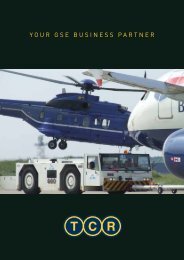WE BRING YOU SAFELY TO TAKE-OFF. - TCR Group
WE BRING YOU SAFELY TO TAKE-OFF. - TCR Group
WE BRING YOU SAFELY TO TAKE-OFF. - TCR Group
Create successful ePaper yourself
Turn your PDF publications into a flip-book with our unique Google optimized e-Paper software.
FEATURE | BOARDING BRIDGES<br />
Regular air travellers have become so used to walking directly<br />
from the terminal lounge onto the aircraft that the need to<br />
walk up steps instead would be almost enough to put people off<br />
flying. But, for airports, choosing passenger boarding bridges<br />
has become a major and expensive exercise.<br />
For a start, there are several different kinds of bridge to choose from.<br />
The old fashioned bridges, such as the T-bridge (named for its shape), are<br />
fast being overtaken by equipment such as flexible Apron Drive models.<br />
Other types of bridges available include nose loaders, commuter<br />
bridges and those specifically designed for the jumbo A380. The A380<br />
bridge needs to be reinforced on the wheels and lifting frame because<br />
the bridge must be higher than normal in order to meet the aircraft<br />
door; the extra height requires extra strength – but also leads to extra<br />
costs. As Grant Smith, in charge of the ramp service group at Burns &<br />
McDonnell, points out: “Everything has to be re-designed for the A380.”<br />
Materials used in bridge construction are changing, too, from the traditional<br />
steel make-up to steel frame with glass panels. “Airports are using<br />
more glass in terminals,” says Peter Reidy, managing editor at Reidy<br />
Airport Terminal Equipment (RATE), which is the agent for CIMC Tianda<br />
in Australia and the South Pacific.<br />
“They are driven by the aesthetic factor: it looks nicer. Now they want<br />
to extend the passenger experience to the bridge, even though glass adds<br />
an average of 5 percent to the cost.”<br />
However, US airports wishing to use glass have an extra hurdle to<br />
overcome first. “The US National Fire Protection Association code covering<br />
glazing specifies that glazing cannot be used within 100 feet of a<br />
fuelling position,” Smith explains.<br />
“As the bridge goes right to the aircraft, it is inevitably very close<br />
to the fuelling point. An airport can get a waiver from the local fire<br />
marshal permitting them to use glass, but some don’t want to take that<br />
responsibility.”<br />
Many do, though. JBT AeroTech supplies numerous glass-panelled<br />
Changing<br />
boarding bridge<br />
technology<br />
Passenger boarding bridges have changed a lot over the years and manufacturers are continuing to develop<br />
more fl exible and nicer looking models<br />
A gate has to be as<br />
flexible as possible:<br />
the more flexibility,<br />
the greater number<br />
of aircraft types can<br />
be handled and the<br />
more opportunity<br />
for airports to attract<br />
new business and<br />
accommodate airline<br />
fleet changes<br />
bridges to US airports. But before an airport authority even gets to the<br />
stage of choosing materials, it has to consider the design of the terminal<br />
and apron. Where a new terminal is being built, the bridge design has to<br />
be included in the initial plans. How many gates will be provided? What<br />
position are they in? What types of aircraft will be using each gate? How<br />
big and long do the bridges need to be? How do the aircraft turn in and<br />
what is their turning space?<br />
The fuelling point has to be considered, too. For narrow-bodied aircraft,<br />
the fuelling point is normally on the right wing; for widebodies,<br />
there are two, one on each wing. The position, length and shape of the<br />
bridge cannot interfere with the fuelling process.<br />
In some cases, an underground hydrant is used. Although often the<br />
most efficient way to re-fuel aircraft, hydrants limit the flexibility of the<br />
gate, as the position of the hydrant pits must be constructed in the most<br />
appropriate place for the aircraft types that will be serviced. If a new<br />
aircraft type is introduced, the hydrant pits may have to be moved – a<br />
difficult task, at best.<br />
MAXIMUM FLEXIBILITY<br />
A gate has to be as flexible as possible: the more flexibility, the greater<br />
number of aircraft types can be handled and the more opportunity for<br />
airports to attract new business and accommodate airline fleet changes.<br />
An airport could, for example, provide four gates which can service narrowbodied<br />
aircraft, at least two of which can be reconfigured for use by<br />
regional jets, with two more designed for wide-bodied aircraft.<br />
Sometimes narrow and widebodied aircraft can use the same bridge;<br />
sometimes they can’t. Often a wide-bodied aircraft is higher off the<br />
ground, with a higher door. A lower aircraft needs a longer boarding<br />
bridge to connect terminal to door - but international safety legislation<br />
restricts the slope of the bridge to less than 14 percent; the average is<br />
between 8 and 10 percent.<br />
This means that for every 8, 10 or 14 feet in length, the bridge can<br />
8 AIRSIDE INTERNATIONAL | OC<strong>TO</strong>BER 2012 WWW.AIRSIDEINT.COM



